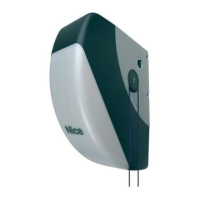14 – ENGLISH
6.1 TESTING
To run the test:
1. verify that all the instructions stated in the “GENERAL
SAFETY WARNINGS AND PRECAUTIONS” chapter
have been strictly observed
2. unlock the gearmotor as indicated in the “Manually un-
locking and locking the gearmotor” paragraph
3. make sure that the leaf can be moved manually during
both the opening and closing phases with a force not ex-
ceeding 225N (roughly 23 kg)
4. lock the gearmotor
5. using the control devices (selector, radio transmitter, etc.),
test the door opening, closing and stoppage phases, en-
suring that the movement matches the specications. Run
several tests to check that the door moves smoothly and
check for any defects in the assembly or adjustment and
any possible points of friction
6. To check the operation of the photocells and ensure that
there is no interference with other devices, pass a cylinder
(5 cm diameter, 30 cm length) on the optical axis, rst
near the “TX” photocell then near “RX” photocell and,
lastly, at the mid-point between the two and verify that in
all these cases the device is triggered, switching from the
active to the alarm status and vice-versa; make sure that
it triggers the intended action in the control unit; for exam-
ple, that it triggers the reversal of movement during the
closing manoeuvre.
7. check, one-by-one, that all safety devices mounted on the
system (photocells, sensitive edges, etc.) work properly.
Each time a device intervenes, the “Bluebus” LED on the
control unit will emit two faster ashes to conrm the rec-
ognition
8. if potentially dangerous situations due to the movement
of the leaves have been prevented by limiting the impact
force, the latter must be measured according to the EN
12445 standard and, if the “motor force” control is used
to aid the system in reducing the impact force, it is neces-
sary to test various adjustments to nd the one that gives
the best results.
6.2 COMMISSIONING
a
Commissioning can only be performed after all test-
ing phases have been successfully completed.
a
Before commissioning the automation, ensure that
the owner is properly informed of all residual risks
and hazards.
a
The gate cannot be commissioned partially or un-
der “temporary” conditions.
To commission the automation:
1. compile the automation’s technical le, which must in-
clude the following documents: overall drawing of the
automation, wiring diagram, risk assessment and relative
solutions adopted, the manufacturer’s declaration of con-
formity for all devices used and the declaration of con-
formity compiled by the installer
2. permanently afx a label or plate in the vicinity of the door,
indicating the operations for the door unlocking and man-
ual manoeuvres “Figure 21“
21
3. permanently afx a label or sign to the door with the fol-
lowing image (minimum height 60 mm) “Figure 22“
22
4. afx a label to the door containing at least the following
data: type of automation, name and address of manufac-
turer (person responsible for commissioning), serial num-
ber, year of manufacture and the CE mark
5. compile the declaration of conformity of the automation
and hand it to the owner of the automation
6. compile the User Manual of the automation and hand it to
the owner of the automation
7. compile and provide the owner with the automation’s
“Maintenance schedule”, containing the maintenance in-
structions for all the automation’s devices.
l
For all the above-mentioned documentation, Nice –
through its technical assistance service – provides
the following: pre-completed forms.

